Results 11,441 to 11,450 of 12091
Thread: Anandtech News
-
02-23-22, 11:23 AM #11441
Anandtech: Intel Launches Alder Lake U and P Series Processors: Ultraportable Laptops
Following the January launch of Intel’s first Alder Lake-based 12th Gen Core mobile processors, the Alder Lake-H family, Intel this morning is following that up with the formal launch of the rest of their mobile product stack. Designed to fill out the lower-power portion of Intel’s product stack for smaller thin and light laptops, today the company is launching the 28 watt Alder Lake-P series processors, as well as the 15 watt and 9 watt Alder Lake-U series processors. Laptops based on both processor sub-families are set to become available in March, where they will be competing against rival AMD’s recently launched Ryzen 6000 Mobile series.
Technically, today’s announcement from Intel is largely a redux in terms of information. The company announced the Alder Lake P and U series alongside the H series chips back at CES, though in a blink-and-you’ll-miss-it fashion, as the bulk of Intel’s efforts were focused around the more imminent H series. But now that the H series launch has passed and the first U/P series laptops are about to hit the market, Intel is giving its lower power processors their moment in the sun.
Along with reiterating on the specifications of the U/P series processors, including clockspeeds, core counts, and integrated GPU configurations, today’s announcement also offers some new concrete details on the overall platform. In particular, we now have confirmation of what I/O options are included for the various low-power chip configurations, as well as the number of USB ports and PCIe lanes available. As well, Intel is also offering a full update on its Evo design program, outlining the updated requirements for Alder Lake Evo laptops.
More...
-
02-24-22, 12:13 PM #11442
Anandtech: The Intel NUC12 Extreme Dragon Canyon Preview: Desktop Alder Lake Impresse
Intel kick-started a form-factor revolution in the early 2010s with the introduction of the ultra-compact NUCs. The systems were meant to be an alternative to the tower desktops used in many applications where the size, shape, and the system capabilities were mostly unwarranted. The success of the NUCs enabled Intel to start reimagining the build of systems used in a wider range of settings.
More recently, the introduction of the Skull Canyon NUC in 2016 was Intel's first effort to make a gaming-focused SFF PC. And desktop-focused Compute Elements (essentially, a motherboard in a PCIe card form-factor) launched in early 2020 meant that full-blown gaming desktops could credibly come under the NUC banner. In the second half of 2020, the Ghost Canyon NUC9 – the first NUC Extreme – made a splash in the market with support for a user-replaceable discrete GPU. Ghost Canyon was extremely impressive, but the restrictions on the dGPU size and high-end pricing were dampeners. Intel made some amends with the NUC11 Extreme (Beast Canyon), using a special Tiger Lake SKU with a 65W TDP and comparatively competitive pricing.
The introduction of Alder Lake and its desktop-first focus has enabled Intel to prepare a new flagship in the NUC Extreme lineup barely 6 months after the launch of the Beast Canyon NUC. The new Dragon Canyon platform was briefly teased at the 2022 CES, with the promise of a Q1 launch. Intel is keeping up its word with the launch of a number of NUC12 Compute Elements and NUC12 Extreme Kit SKUs. Today, we are having a detailed look at what the NUC12 Extreme brings to the table, particularly in comparison to the NUC11 Extreme. The recent introduction of Windows 11 means that our benchmarks comparison set is currently limited - today's preview does not deal with any systems other than the NUC12 Extreme and NUC11 Extreme.
More...
-
02-25-22, 07:46 PM #11443
Anandtech: The GIGABYTE Z690 Aorus Master Mobo Review: 10GbE Rounds Out A Premium Boa
The latest motherboard to grace our test bench is the GIGABYTE Z690 Aorus Master, which hails from its Aorus gaming series and sits just one step below its Aorus Xtreme models. Some of its most notable features include 10 Gigabit Ethernet and Wi-FI 6E networking, USB 3.2 G2x2 connectivity, as well as plenty of storage capacity consisting of five M.2 slots and six SATA ports. The Aorus Z690 Master also boasts support for DDR5-6400 memory and an impressive 20-phase power delivery designed for overclockers looking to squeeze out extra performance. Does the GIGABYTE Z690 Aorus have enough about it to justify the $470 price tag? We aim to find out in our latest Z690 motherboard review.
More...
-
02-28-22, 06:01 PM #11444
Anandtech: Bitspower Quietly Launches its First Ever Air CPU Cooler, The Phantom
More known for its custom water cooling components, Bitspower has released its first-ever air-based CPU cooler, the Phantom. Designed for the entry-level market, the Phantom includes a single 120 mm RGB enabled cooling fan and supports Intel's latest LGA1700 desktop socket and AMD's AM4 socket.
With a height of 158 mm, the Phantom is compatible with most desktop cases. It is constructed of aluminum, with four copper heat pipes attaching the large aluminum fin stack to the cold plate. To aid in heat dissipation, it uses a single 120 mm cooling fan which includes RGB for users looking to add a bit of flair to their system. The cooling fan included has a maximum speed of 1800 RPM, which Bitspower claims the fan has an airflow rating of 80 CFM, and it operates with a maximum volume of 34 dBA.
Despite the official listing on the Bitspower website not providing much information on specification and capability, I reached out to Bitspower CEO Vincent Yu and confirmed what the webpage leaves out. This includes the official dimensions of the Bitspower Phantom CPU cooler, which has a relatively small footprint of 116 x 51 x 158 mn. Vincent Yu also confirmed that the Bitspower Phantom could dissipate heat from most desktop processors, with a rated TDP of 200 W.
The Bitspower Phantom air cooler is available directly from its website for 1450 TWD. Still, Bitspower has confirmed to me that it will be available in other regions soon with an expected MSRP of $55.
Gallery: Bitspower Quietly Launches The Phantom CPU Air Cooler




Source: Bitspower
Related Reading- The Noctua PH-P1 Passive CPU Cooler Review: Silent Giant
- The Be Quiet! Pure Loop 280mm AIO Cooler Review: Quiet Without Compromise
- The Noctua NH-U12S Redux Cooler Review: Bringing Noctua's Best To a Lower Price
- The SilverStone IceGem AIO Coolers Review: Going Big For Threadripper
More...
-
03-01-22, 08:56 AM #11445
Anandtech: AMD's Ryzen 9 6900HS Rembrandt Benchmarked: Zen3+ Power and Performance Sc
Earlier this year, AMD announced an update to its mobile processor line that we weren’t expecting quite so soon. The company updated its Ryzen 5000 Mobile processors, which are based around Zen3 and Vega cores, to Ryzen 6000 Mobile, which use Zen3+ and RDNA2 cores. The jump from Vega to RDNA2 on the graphics side was an element we had been expecting at some point, but the emergence of a Zen3+ core was very intriguing. AMD gave us a small pre-brief, saying that the core is very similar to Zen3, but with ~50 new power management features and techniques inside. With the first laptops based on these chips now shipping, we were sent one of the flagship models for a quick test.
More...
-
03-01-22, 04:11 PM #11446
Anandtech: Lenovo Announces The ThinkPad X13s Laptop, Powered By Snapdragon 8cx Gen 3
During the MWC 2022 trade show in Barcelona, Lenovo unveiled the first laptop powered by Qualcomm's new Snapdragon 8cx Gen 3 chip, the ThinkPad X13s. Using a passively-cooled design, Lenovo is claiming that the ThinkPad X13s has a long battery life with up to 28 hours of video playback, as well as boasting plenty of wireless connectivity, including support for 5G mmWave, Wi-Fi 6E, and is all housed in a 90% recycled magnesium chassis.
Over the last couple of months, we've dedicated a number of column inches to Qualcomm's latest Snapdragon 8cx Gen 3. It uses four Arm Cortex-X1 prime cores at 3.0 GHz, four smaller A78 efficiency cores operating at 2.4 GHz, and it also includes the company's latest Adreno graphics.
The biggest challenge for Qualcomm with the Snapdragon 8cx Gen 3 and the Windows on Arm project has been application compatibility. Qualcomm has been working closely with Microsoft and software vendors to allow its Arm-based processors to work with x86 apps, and last year's launch of Windows 11 added x86-64 application compatibility as well. So these days it's less a matter of what will work on WoA laptops, and more about how quickly x86 applications will run.
For more details on the Qualcomm Snapdragon 8cx Gen 3 processor, as well as our interviews with Qualcomm SVP Alex Katouzian and VP For Windows and Chrome PCs at Qualcomm, Miguel Nunes, check out the links below:
- Qualcomm's 8cx Gen 3 for Notebooks, Nuvia Core in 2022/2023
- Interview with Alex Katouzian, Qualcomm SVP: Talking Snapdragon, Microsoft, Nuvia, and Discrete Graphics
- AnandTech Interview with Miguel Nunes: VP For Windows and Chrome PCs, Qualcomm
Focusing on Lenovo's big announcement at MWC 2022, it has launched several new notebooks for 2022, but all eyes are on the ThinkPad X13s. Lenovo, of course, is a large and respected name in the productivity laptop space, so their willingness (or unwillingness) to adopt new CPUs/SoCs is often a good barometer of overall OEM interest in new chips.
Aside from being the first consumer-based notebook powered by the Qualcomm Snapdragon 8cx Gen 3 processor, the ThinkPad X13s has a wide variety of features for users on the go, both focusing on productivity and longevity, all housed inside a 0.53-inch thick frame.
A big talking point surrounds the battery life of the ThinkPad X13s, with Lenovo claiming an impressive 28-hours of usage between charges. While this sounds impressive on paper, the onus is on the types of workloads being used, with Lenovo quoting video playback figures with its 49.5-Wh Li-ion Polymer battery. It has dimensions of 11.76 x 13 x 0.53-inches (WxDxH), is constructed from 90% certified recycled magnesium, and weighs just 2.35 lbs making it ultra-portable and lightweight.
Lenovo offers the ThinkPad X13s with three different display types: an IPS AG 300-nit panel, an IPS touch AG 300-nit panel, and a low-power IPS AG display with 400-nits of brightness. All three display types include a 13.3-inch screen with an aspect ratio of 16:10 and an output resolution of 1920 x 1080p.
Housing within the central section of the top bezel, the Lenovo ThinkPad X13s can be equipped with two different webcams, one of which has 5MP RGB, while the other is a 5MP IR camera with support for Computer Vision presence detection. In terms of connectivity, the ThinkPad X13s has two USB 3.2 G2 Type-C ports, with one 3.5 mm audio jack and a SIM card slot. The SIM card slot allows users to access either 5G sub6 or 5G mmWave depending on the configuration. At the same time, Lenovo also offers users the choice of Wi-Fi 6 or Wi-Fi 6E wireless networking.
Lenovo has stated that the Qualcomm Snapdragon 8cx Gen 3 powered ThinkPad X13s will be available in May, with prices starting at $1099. It also states that in the US, the ThinkPad X13s will be available on carriers including AT&T and Verizon sometime in 2022.Lenovo ThinkPad X13s Specifications Component Surface Laptop Studio CPU Snapdragon 8cx Gen 3 GPU Snapdragon 8cx Gen 3 Adreno Display 13.3" WUXGA (16:10) 300-nit IPS AG (1920x1080)
13.3" WUXGA (16:10) 300-nit IPS Touch AG (1920x1080)
13.3" WUXGA (16:10) Low Power 400-nit IPS AG (1920x1080)RAM Up to 32 GB LPDDR4x (soldered) Dual-Channel Storage Up to 1 TB PCIe SSD Networking Wi-Fi 6/6E
5G sub6 eSIM
5G mmWave eSIMI/O 2 x USB Gen 3.2 Type-C
1 x Audio Jack
SIM Card SlotBattery Up to 28 hours
49.5 Wh Li-ion Polymer BatteryCamera 5MP RGB Camera
5MP IR Camera /w Computer VisionOperating System Windows 11 Dimensions (inches) 11.76 x 13 x 0.53 Weight 2.35 lbs Starting Price (USD) $1,099
Gallery: Lenovo Launches The ThinkPad X13s Laptop, Powered By Snapdragon 8cx Gen 3





Source: Lenovo
Related Reading- Qualcomm's 8cx Gen 3 for Notebooks, Nuvia Core in 2022/2023
- Interview with Alex Katouzian, Qualcomm SVP: Talking Snapdragon, Microsoft, Nuvia, and Discrete Graphics
- AnandTech Interview with Miguel Nunes: VP For Windows and Chrome PCs, Qualcomm
- Qualcomm Shows Off Snapdragon Dev Kit for Windows on Arm Development
More...
-
03-02-22, 12:10 PM #11447
Anandtech: Universal Chiplet Interconnect Express (UCIe) Announced: Setting Standards
If there has been one prominent, industry-wide trend in chip design over the past half-decade or so, it has been the growing use of chiplets. The tiny dies have become an increasingly common feature as chip makers look to them to address everything from chip manufacturing costs to the overall scalability of a design. Be it simply splitting up a formerly monolithic CPU in to a few pieces, or going to the extreme with 47 chiplets on a single package, chiplets are already playing a big part in chip design today, and chip makers have made it clear that it’s only going to grow in the future.
In the meantime, after over 5 years of serious, high-volume use, chiplets and the technologies underpinning them seem to finally be reaching an inflection point in terms of design. Chip makers have developed a much better idea of what chiplets are (and are not) good for, packaging suppliers have refined their ultra-precise methods needed to place chiplets, and engineering teams have ironed out the communications protocols used to have chiplets talk amongst each other. In short, chiplets are no longer experimental designs that need to be proven, but instead have become proven designs that chip makers can rely on. And with that increasing reliance on chiplet technology comes the need for design roadmaps and stability – the need for design standards.
To that end, today Intel, AMD, Arm, and all three leading-edge foundries are coming together to announce that they are forming a new and open standard for chiplet interconnects, which is aptly being named Universal Chiplet Interconnect Express, or UCIe. Taking significant inspiration from the very successful PCI-Express playbook, with UCIe the involved firms are creating a standard for connecting chiplets, with the goal of having a single set of standards that not only simplify the process for all involved, but lead the way towards full interoperability between chiplets from different manufacturers, allowing chips to mix-and-match chiplets as chip makers see fit. In other words, to make a complete and compatible ecosystem out of chiplets, much like today’s ecosystem for PCIe-based expansion cards.
More...
-
03-03-22, 08:51 AM #11448
Anandtech: The Intel Core i3-12300 Review: Quad-Core Alder Lake Shines
Just over a month ago Intel pulled the trigger on the rest of its 12th generation "Alder Lake" Core desktop processors, adding no fewer than 22 new chips. This significantly fleshed out the Alder Lake family, adding in the mid-range and low-end chips that weren't part of Intel's original, high-end focused launch. Combined with the launch of the rest of the 600 series chipsets, this finally opened the door to building cheaper and lower-powered Alder Lake systems.
Diving right in, today we're taking a look at Intel's Core i3-12300 processor, the most powerful of the new I3s. Like the entire Alder Lake i3 series, the i3-12300 features four P-cores, and is aimed to compete in the entry-level and budget desktop market. With prices being driven higher on many components and AMD's high-value offerings dominating the lower end of the market, it's time to see if Intel can compete in the budget desktop market and offer value in a segment that currently needs it.
More...
-
03-03-22, 08:51 AM #11449
Anandtech: SPEC Adds Linux Edition of SPECviewperf 2020 v3.0 Benchmark
The SPEC Graphics Performance Characterization (SPECgpc) group updated the Windows version of the workstation GPU benchmark suite - SPECviewperf 2020 - twice last year. The intent of the benchmark is to replay GPU workload traces from real-world professional applications (Maya for media and entertainment, Catia, Creo, NX, and Solidworks for CAD/CAM, OpendTect for the energy industry, and the Tuvok visualization library for rendering medical images). Version 3.0, released in December 2021, updated the Solidworks viewset to better reflect the OpenGL API calls in the latest version of the software. Version 2.0 had enabled selective downloading of the viewsets.
While the Windows version of the benchmark had been through three versions, the Linux community was left out, having to rely on the SPECviewperf 13 released almost a decade ago. That is changing today with the availability of the Linux edition of SPECviewperf 2020 v3.0. The benchmark updates the viewsets with traces from the latest versions of the relevant applications and also updates the models to match the Windows version. Since the benchmarks wrapper framework (even for the Windows version) is based on Node-Webkit (now NW.js), the creation of a Linux edition had to mainly deal with the actual viewset processing. Automation and results processing are identical between the Windows and Linux versions.
Unlike SPECviewperf 13 Linux Edition which was distributed as a compressed tar archive, the SPECviewperf 2020 v3.0 Linux Edition is a .deb package. The benchmark requires Canonical Ubuntu Linux 20.04, 16GB or more of RAM, and 80GB of fixed disk drive space. Viewsets are processed at two resolutions - 1080p and 4K, with 1080p being the minimum. The GPU drivers are required to support OpenGL 4.5, and the GPU itself needs to have 2GB minimum VRAM.
The benchmark is available for download free of cost for everyone other than vendors of computers and related products / services who are not members of SPEC/GWPG. Such vendors can purchase a license for $2500.
Linux has a much greater market share in the workstation segment compared to consumer desktops. It is heartening to see SPECgpc finally replace the aging Linux edition of SPECviewperf 13 . The latest viewsets and models in the SPECviewperf 2020 v3.0 Linux Edition bring it on par with the benchmarking capabilities of the Windows edition.
More...
-
03-03-22, 03:50 PM #11450
Anandtech: ASRock Industrial's NUC1200 BOX Series Brings Alder Lake to UCFF Systems
Intel recently updated their low-power processors lineup with the Alder Lake U and P Series 12th Gen Core mobile SKUs. With support for a range of TDPs up to 28W, these allow ultra-compact form-factor (UCFF) PC manufacturers to update their traditional NUC clones. Similar to the Tiger Lake generation, ASRock Industrial is again at the forefront - launching the NUC1200 BOX Series within a few days of Intel's announcement.
The new NUC1200 BOX Series retains the chassis design and form-factor of the NUC1100 BOX Series. The NUC BOX-1165G7 left a favorable impression in our hands-on review, and the NUC1200 BOX Series seems to be carrying over all those aspects. The company is launching three models in this series - NUC BOX-1260P, NUC BOX-1240P, and NUC BOX-1220P. The specifications are summarized in the table below.
According to the products' datasheet, ASRock Industrial plans to get the two Type-C ports in the front panel certified for USB4. Since the certification plan is still pending, they are being advertised as USB 3.2 Gen 2 for now. Going by our experience with the NUC-BOX1165G7, at least one of the front Type-C ports should be able to support Thunderbolt 4 peripherals.ASRock Industrial NUC 1200 BOX (Alder Lake-P) Lineup Model NUC BOX-1260P NUC BOX-1240P NUC BOX-1220P CPU Intel Core i7-1260P
4C + 8c / 16T
(C) 2.1 - 4.7 GHz
(c) 1.5 - 3.4 GHz
20 - 64W (28W)Intel Core i5-1240P
4C + 8c / 16T
(C) 1.7 - 4.4 GHz
(c) 1.2 - 3.3 GHz
20 - 64W (28W)Intel Core i3-1220P
2C + 8c / 12T
(C) 1.5 - 4.4 GHz
(c) 1.1 - 3.3 GHz
20 - 64W (28W)GPU Intel® Iris Xe Graphics (96EU) @ 1.4 GHz Intel® Iris® Xe Graphics (80EU) @ 1.3 GHz Intel® UHD Graphics for 12th Gen Intel® Processors (64EU) @ 1.1 GHz DRAM Two DDR4 SO-DIMM slots
Up to 64 GB of DDR4-3200 in dual-channel modeMotherboard 4.02" x 4.09" UCFF Storage SSD 1x M.2-22(42/60/80) (PCIe 4.0 x4 (CPU-direct)) DFF 1 × SATA III Port (for 2.5" drive) Wireless Intel Wi-Fi 6E AX211
2x2 802.11ax Wi-Fi (2.4Gbps) + Bluetooth 5.2 moduleEthernet 2 × 2.5GbE port (Intel I225-LM) USB Front 1 × USB 3.2 Gen 2 Type-A
2 x USB 3.2 Gen 2 Type-C (USB4 Certification Pending)Rear 2 × USB 3.2 Gen 2 Type-A Display Outputs 1 × HDMI 2.0b
1 x DisplayPort 1.4a
2 × DisplayPort 1.4a (using Front Panel Type-C ports)Audio 1 × 3.5mm audio jack (Realtek ALC233) PSU External (19V/90W) Dimensions Length: 117.5 mm
Width: 110 mm
Height: 47.85 mmMSRP ? ? ?
The key updates over the NUC1100 BOX series seem to be the integration of dual 2.5GbE ports (compared to 1x 1GbE + 1x 2.5GbE), addition of 6GHz Wi-Fi support, and the presence of Alder Lake processors with their hybrid architecture comprising of both performance and efficiency cores.
Since the units target the embedded market also, they have the usual bells and whistles including an integrated watchdog timer and an on-board TPM. Pricing is slated to be announced in the coming months.
Gallery: ASRock Industrial's NUC1200 BOX Series Brings Alder Lake to UCFF Systems

More...
Thread Information
Users Browsing this Thread
There are currently 15 users browsing this thread. (0 members and 15 guests)





 Quote
Quote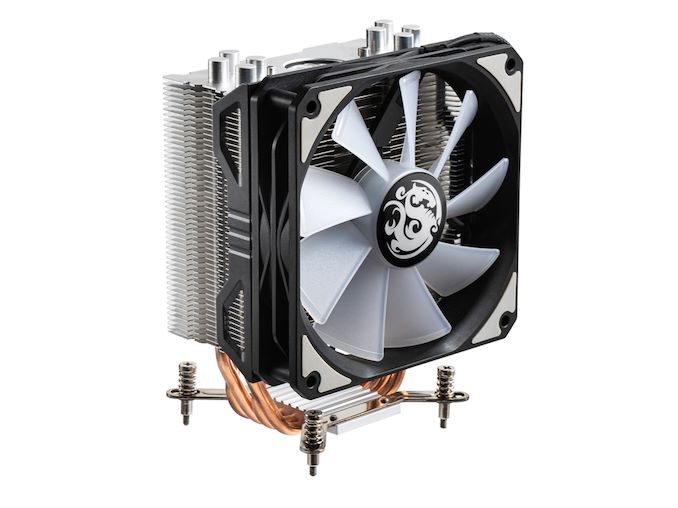
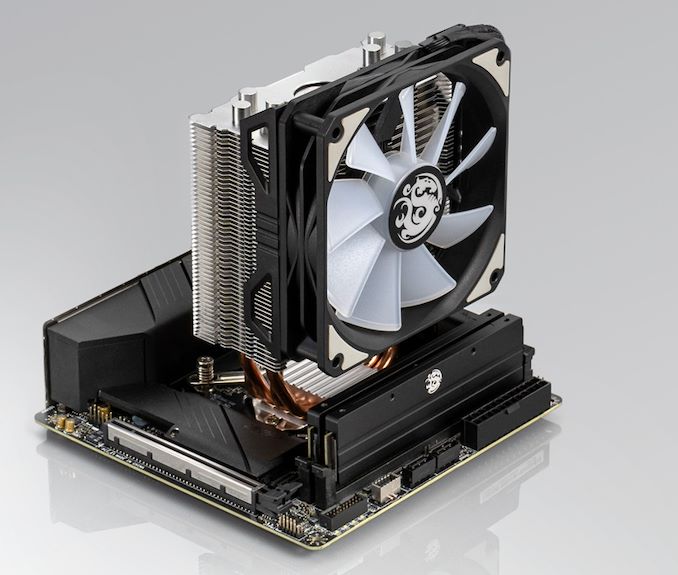
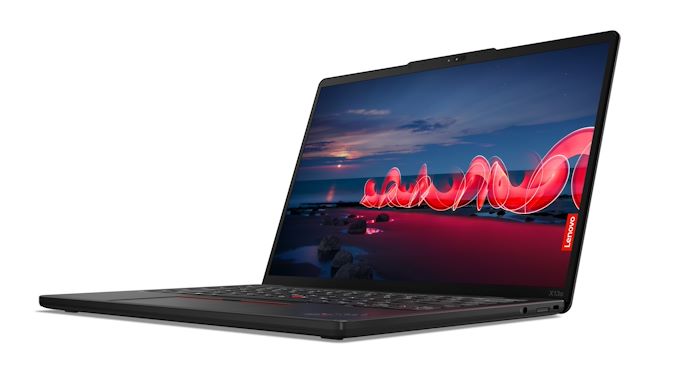


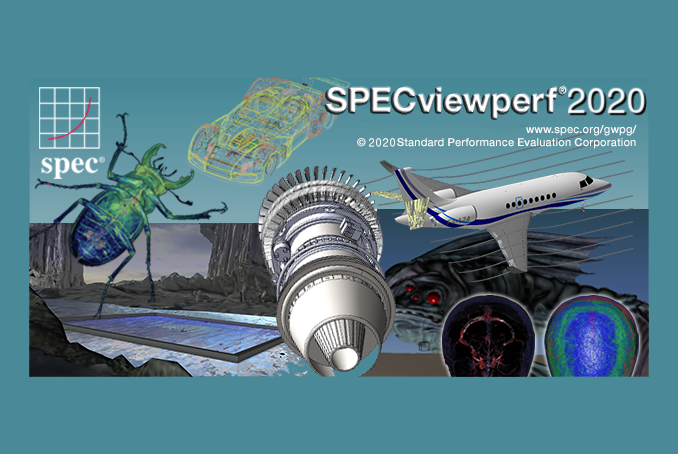
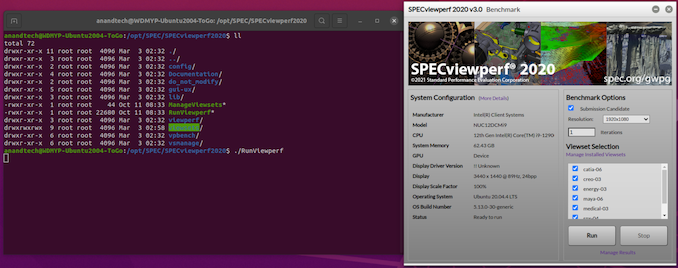
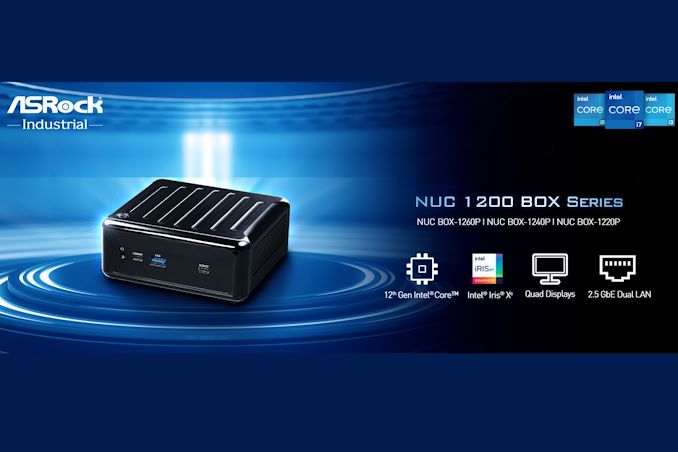
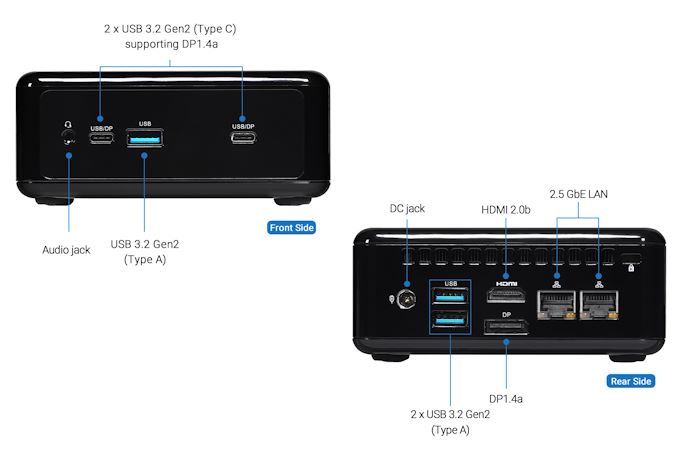
















Bookmarks